HAT202 - Springhill Hospitality Industry: Business Portfolio Analysis
VerifiedAdded on 2023/06/11
|8
|1441
|85
Portfolio
AI Summary
This business portfolio provides an overview of the Springhill Hospitality Industry (SHI), detailing its services such as cruise lines, transportation, theme parks, event planning, and lodging. It highlights the company's current business operations, including distribution channels, pricing models, and customer segmentation strategies based on geography, demographics, and psychographics. The portfolio also discusses branding and promotion strategies, emphasizing digital marketing efforts through social media. Furthermore, it recommends future integrated marketing campaigns utilizing various communication media and suggests innovative ideas for market segment engagement and service upgrades. The analysis includes visual aids like service samples and a location map, concluding with a list of references. Desklib provides similar solved assignments and resources for students.

BUSINESS PORTFOLIO 1
BUSINESS PORTFOLIO
Student’s Name
Professor
Institution Affiliation
Date
BUSINESS PORTFOLIO
Student’s Name
Professor
Institution Affiliation
Date
Paraphrase This Document
Need a fresh take? Get an instant paraphrase of this document with our AI Paraphraser
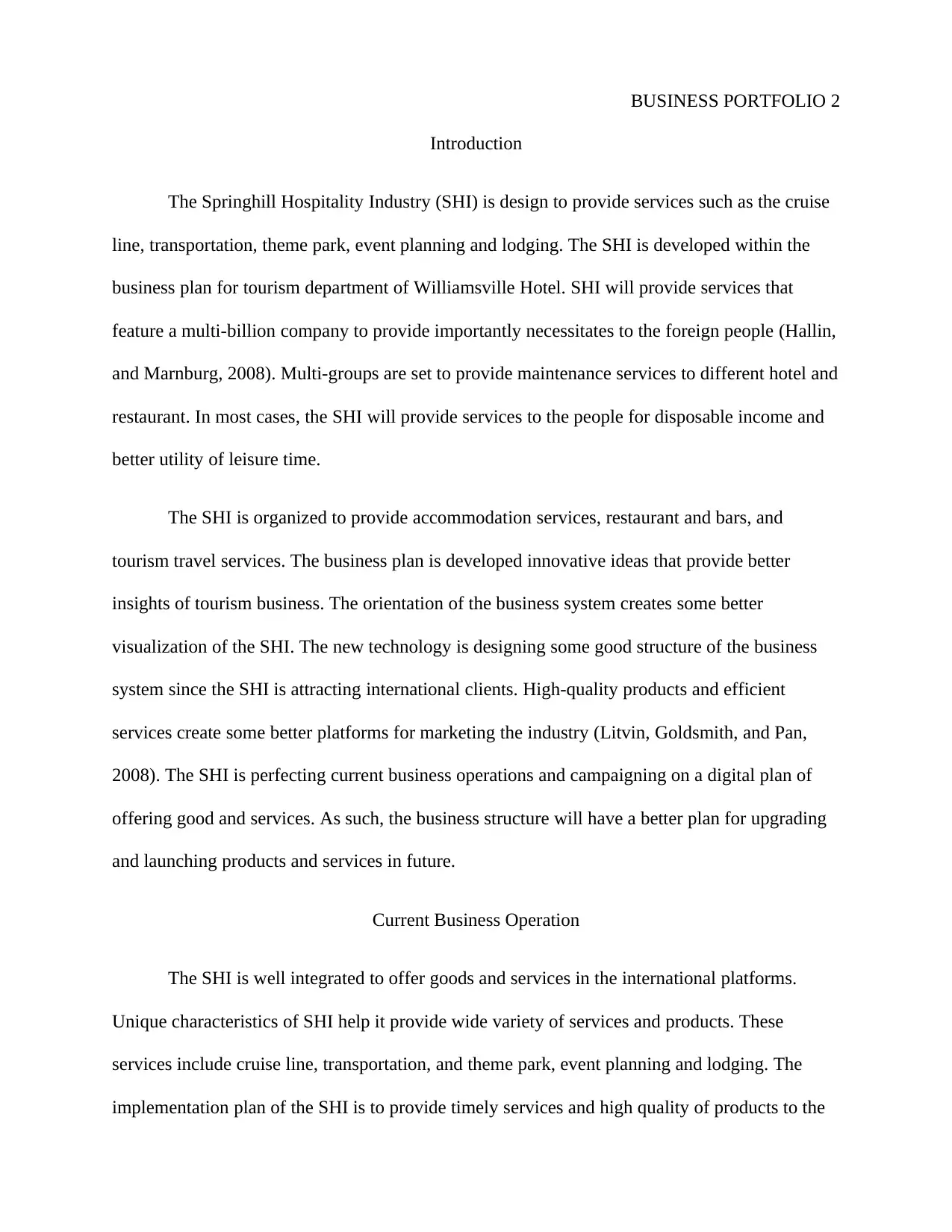
BUSINESS PORTFOLIO 2
Introduction
The Springhill Hospitality Industry (SHI) is design to provide services such as the cruise
line, transportation, theme park, event planning and lodging. The SHI is developed within the
business plan for tourism department of Williamsville Hotel. SHI will provide services that
feature a multi-billion company to provide importantly necessitates to the foreign people (Hallin,
and Marnburg, 2008). Multi-groups are set to provide maintenance services to different hotel and
restaurant. In most cases, the SHI will provide services to the people for disposable income and
better utility of leisure time.
The SHI is organized to provide accommodation services, restaurant and bars, and
tourism travel services. The business plan is developed innovative ideas that provide better
insights of tourism business. The orientation of the business system creates some better
visualization of the SHI. The new technology is designing some good structure of the business
system since the SHI is attracting international clients. High-quality products and efficient
services create some better platforms for marketing the industry (Litvin, Goldsmith, and Pan,
2008). The SHI is perfecting current business operations and campaigning on a digital plan of
offering good and services. As such, the business structure will have a better plan for upgrading
and launching products and services in future.
Current Business Operation
The SHI is well integrated to offer goods and services in the international platforms.
Unique characteristics of SHI help it provide wide variety of services and products. These
services include cruise line, transportation, and theme park, event planning and lodging. The
implementation plan of the SHI is to provide timely services and high quality of products to the
Introduction
The Springhill Hospitality Industry (SHI) is design to provide services such as the cruise
line, transportation, theme park, event planning and lodging. The SHI is developed within the
business plan for tourism department of Williamsville Hotel. SHI will provide services that
feature a multi-billion company to provide importantly necessitates to the foreign people (Hallin,
and Marnburg, 2008). Multi-groups are set to provide maintenance services to different hotel and
restaurant. In most cases, the SHI will provide services to the people for disposable income and
better utility of leisure time.
The SHI is organized to provide accommodation services, restaurant and bars, and
tourism travel services. The business plan is developed innovative ideas that provide better
insights of tourism business. The orientation of the business system creates some better
visualization of the SHI. The new technology is designing some good structure of the business
system since the SHI is attracting international clients. High-quality products and efficient
services create some better platforms for marketing the industry (Litvin, Goldsmith, and Pan,
2008). The SHI is perfecting current business operations and campaigning on a digital plan of
offering good and services. As such, the business structure will have a better plan for upgrading
and launching products and services in future.
Current Business Operation
The SHI is well integrated to offer goods and services in the international platforms.
Unique characteristics of SHI help it provide wide variety of services and products. These
services include cruise line, transportation, and theme park, event planning and lodging. The
implementation plan of the SHI is to provide timely services and high quality of products to the
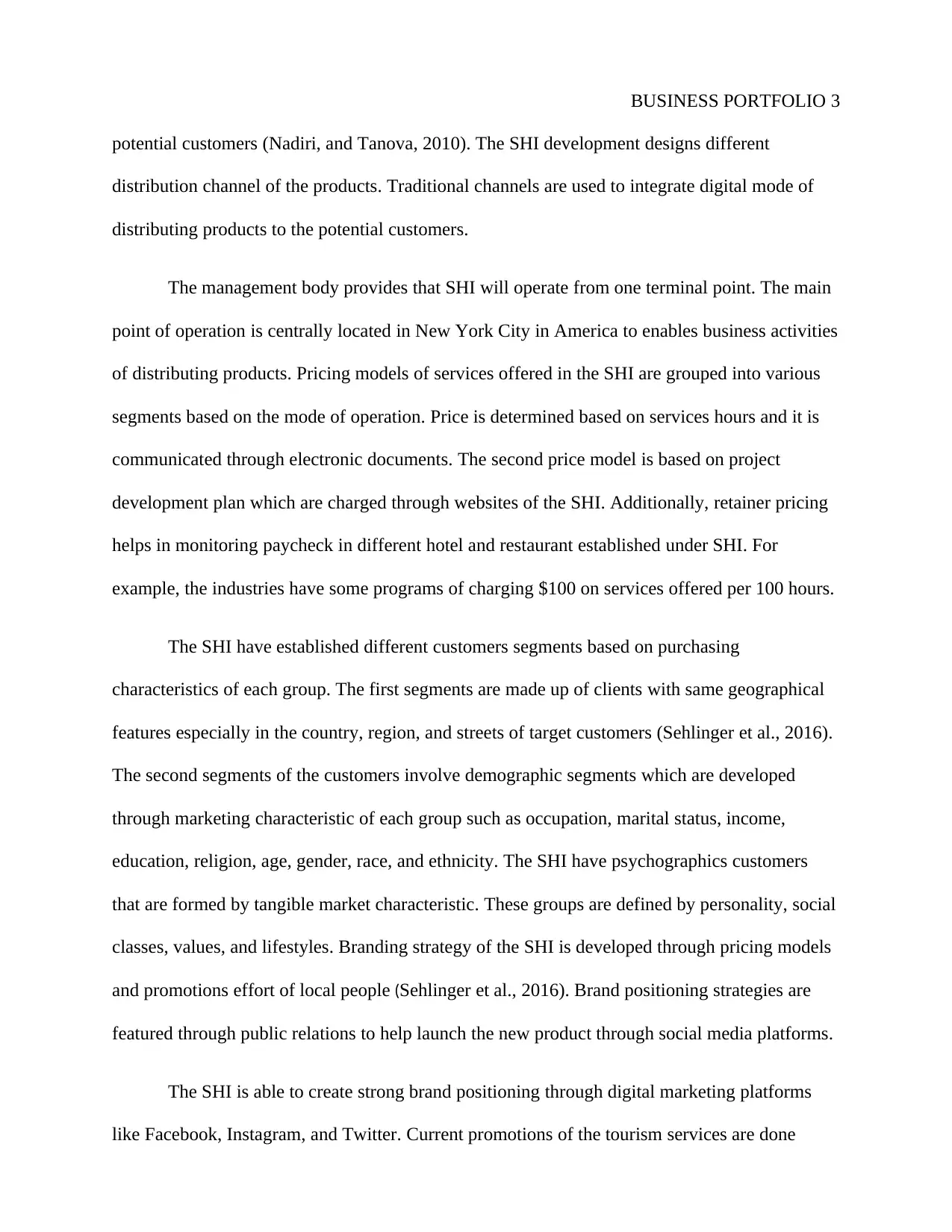
BUSINESS PORTFOLIO 3
potential customers (Nadiri, and Tanova, 2010). The SHI development designs different
distribution channel of the products. Traditional channels are used to integrate digital mode of
distributing products to the potential customers.
The management body provides that SHI will operate from one terminal point. The main
point of operation is centrally located in New York City in America to enables business activities
of distributing products. Pricing models of services offered in the SHI are grouped into various
segments based on the mode of operation. Price is determined based on services hours and it is
communicated through electronic documents. The second price model is based on project
development plan which are charged through websites of the SHI. Additionally, retainer pricing
helps in monitoring paycheck in different hotel and restaurant established under SHI. For
example, the industries have some programs of charging $100 on services offered per 100 hours.
The SHI have established different customers segments based on purchasing
characteristics of each group. The first segments are made up of clients with same geographical
features especially in the country, region, and streets of target customers (Sehlinger et al., 2016).
The second segments of the customers involve demographic segments which are developed
through marketing characteristic of each group such as occupation, marital status, income,
education, religion, age, gender, race, and ethnicity. The SHI have psychographics customers
that are formed by tangible market characteristic. These groups are defined by personality, social
classes, values, and lifestyles. Branding strategy of the SHI is developed through pricing models
and promotions effort of local people (Sehlinger et al., 2016). Brand positioning strategies are
featured through public relations to help launch the new product through social media platforms.
The SHI is able to create strong brand positioning through digital marketing platforms
like Facebook, Instagram, and Twitter. Current promotions of the tourism services are done
potential customers (Nadiri, and Tanova, 2010). The SHI development designs different
distribution channel of the products. Traditional channels are used to integrate digital mode of
distributing products to the potential customers.
The management body provides that SHI will operate from one terminal point. The main
point of operation is centrally located in New York City in America to enables business activities
of distributing products. Pricing models of services offered in the SHI are grouped into various
segments based on the mode of operation. Price is determined based on services hours and it is
communicated through electronic documents. The second price model is based on project
development plan which are charged through websites of the SHI. Additionally, retainer pricing
helps in monitoring paycheck in different hotel and restaurant established under SHI. For
example, the industries have some programs of charging $100 on services offered per 100 hours.
The SHI have established different customers segments based on purchasing
characteristics of each group. The first segments are made up of clients with same geographical
features especially in the country, region, and streets of target customers (Sehlinger et al., 2016).
The second segments of the customers involve demographic segments which are developed
through marketing characteristic of each group such as occupation, marital status, income,
education, religion, age, gender, race, and ethnicity. The SHI have psychographics customers
that are formed by tangible market characteristic. These groups are defined by personality, social
classes, values, and lifestyles. Branding strategy of the SHI is developed through pricing models
and promotions effort of local people (Sehlinger et al., 2016). Brand positioning strategies are
featured through public relations to help launch the new product through social media platforms.
The SHI is able to create strong brand positioning through digital marketing platforms
like Facebook, Instagram, and Twitter. Current promotions of the tourism services are done
⊘ This is a preview!⊘
Do you want full access?
Subscribe today to unlock all pages.

Trusted by 1+ million students worldwide
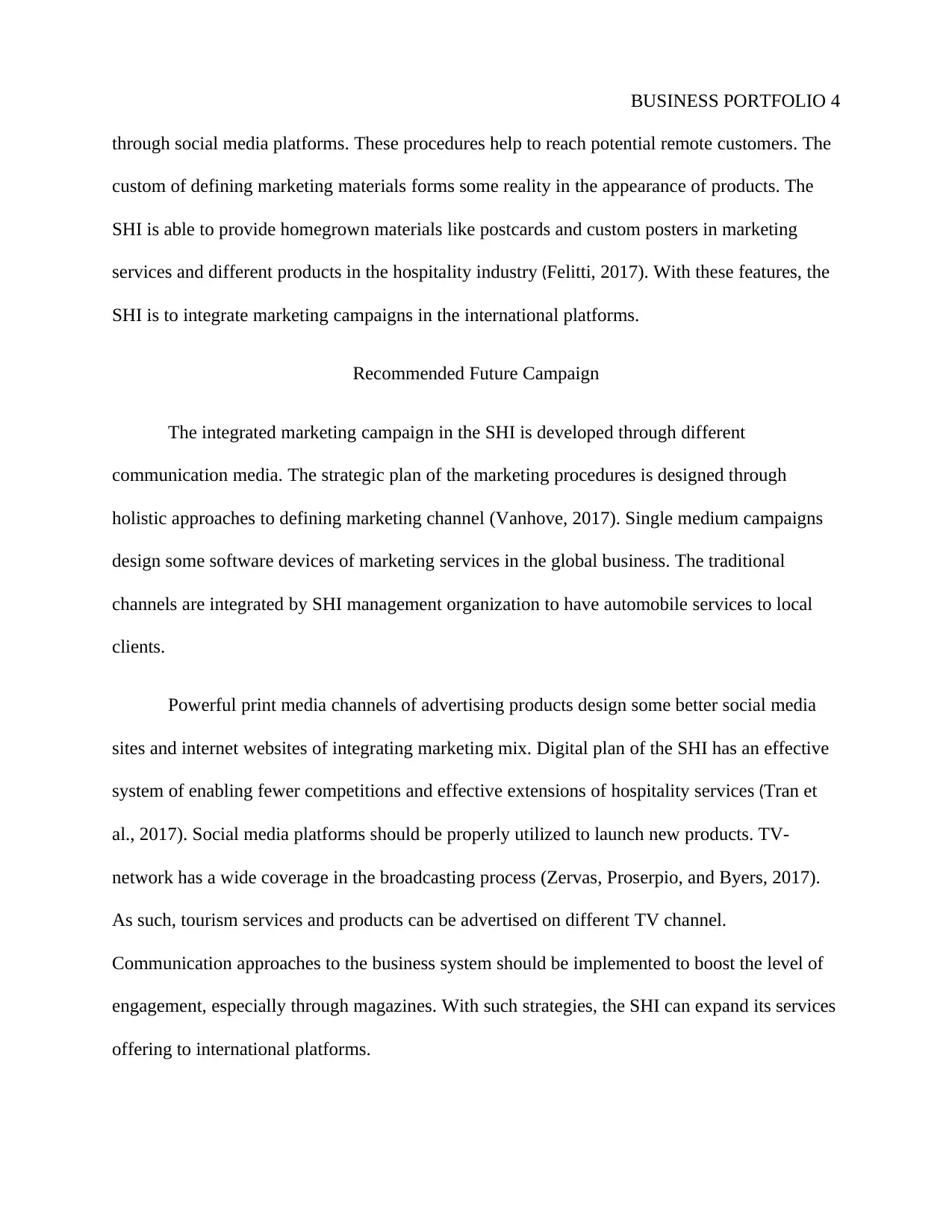
BUSINESS PORTFOLIO 4
through social media platforms. These procedures help to reach potential remote customers. The
custom of defining marketing materials forms some reality in the appearance of products. The
SHI is able to provide homegrown materials like postcards and custom posters in marketing
services and different products in the hospitality industry (Felitti, 2017). With these features, the
SHI is to integrate marketing campaigns in the international platforms.
Recommended Future Campaign
The integrated marketing campaign in the SHI is developed through different
communication media. The strategic plan of the marketing procedures is designed through
holistic approaches to defining marketing channel (Vanhove, 2017). Single medium campaigns
design some software devices of marketing services in the global business. The traditional
channels are integrated by SHI management organization to have automobile services to local
clients.
Powerful print media channels of advertising products design some better social media
sites and internet websites of integrating marketing mix. Digital plan of the SHI has an effective
system of enabling fewer competitions and effective extensions of hospitality services (Tran et
al., 2017). Social media platforms should be properly utilized to launch new products. TV-
network has a wide coverage in the broadcasting process (Zervas, Proserpio, and Byers, 2017).
As such, tourism services and products can be advertised on different TV channel.
Communication approaches to the business system should be implemented to boost the level of
engagement, especially through magazines. With such strategies, the SHI can expand its services
offering to international platforms.
through social media platforms. These procedures help to reach potential remote customers. The
custom of defining marketing materials forms some reality in the appearance of products. The
SHI is able to provide homegrown materials like postcards and custom posters in marketing
services and different products in the hospitality industry (Felitti, 2017). With these features, the
SHI is to integrate marketing campaigns in the international platforms.
Recommended Future Campaign
The integrated marketing campaign in the SHI is developed through different
communication media. The strategic plan of the marketing procedures is designed through
holistic approaches to defining marketing channel (Vanhove, 2017). Single medium campaigns
design some software devices of marketing services in the global business. The traditional
channels are integrated by SHI management organization to have automobile services to local
clients.
Powerful print media channels of advertising products design some better social media
sites and internet websites of integrating marketing mix. Digital plan of the SHI has an effective
system of enabling fewer competitions and effective extensions of hospitality services (Tran et
al., 2017). Social media platforms should be properly utilized to launch new products. TV-
network has a wide coverage in the broadcasting process (Zervas, Proserpio, and Byers, 2017).
As such, tourism services and products can be advertised on different TV channel.
Communication approaches to the business system should be implemented to boost the level of
engagement, especially through magazines. With such strategies, the SHI can expand its services
offering to international platforms.
Paraphrase This Document
Need a fresh take? Get an instant paraphrase of this document with our AI Paraphraser
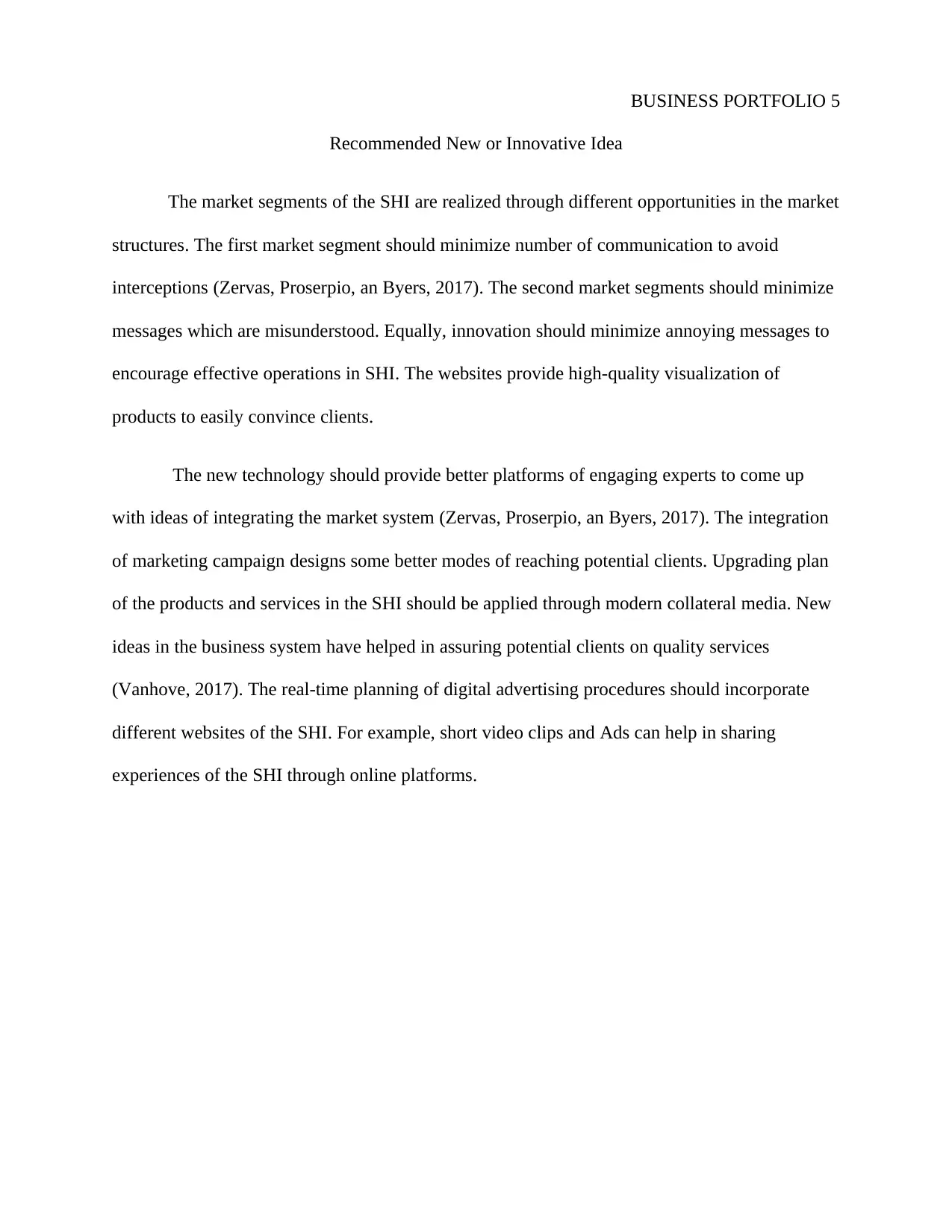
BUSINESS PORTFOLIO 5
Recommended New or Innovative Idea
The market segments of the SHI are realized through different opportunities in the market
structures. The first market segment should minimize number of communication to avoid
interceptions (Zervas, Proserpio, an Byers, 2017). The second market segments should minimize
messages which are misunderstood. Equally, innovation should minimize annoying messages to
encourage effective operations in SHI. The websites provide high-quality visualization of
products to easily convince clients.
The new technology should provide better platforms of engaging experts to come up
with ideas of integrating the market system (Zervas, Proserpio, an Byers, 2017). The integration
of marketing campaign designs some better modes of reaching potential clients. Upgrading plan
of the products and services in the SHI should be applied through modern collateral media. New
ideas in the business system have helped in assuring potential clients on quality services
(Vanhove, 2017). The real-time planning of digital advertising procedures should incorporate
different websites of the SHI. For example, short video clips and Ads can help in sharing
experiences of the SHI through online platforms.
Recommended New or Innovative Idea
The market segments of the SHI are realized through different opportunities in the market
structures. The first market segment should minimize number of communication to avoid
interceptions (Zervas, Proserpio, an Byers, 2017). The second market segments should minimize
messages which are misunderstood. Equally, innovation should minimize annoying messages to
encourage effective operations in SHI. The websites provide high-quality visualization of
products to easily convince clients.
The new technology should provide better platforms of engaging experts to come up
with ideas of integrating the market system (Zervas, Proserpio, an Byers, 2017). The integration
of marketing campaign designs some better modes of reaching potential clients. Upgrading plan
of the products and services in the SHI should be applied through modern collateral media. New
ideas in the business system have helped in assuring potential clients on quality services
(Vanhove, 2017). The real-time planning of digital advertising procedures should incorporate
different websites of the SHI. For example, short video clips and Ads can help in sharing
experiences of the SHI through online platforms.
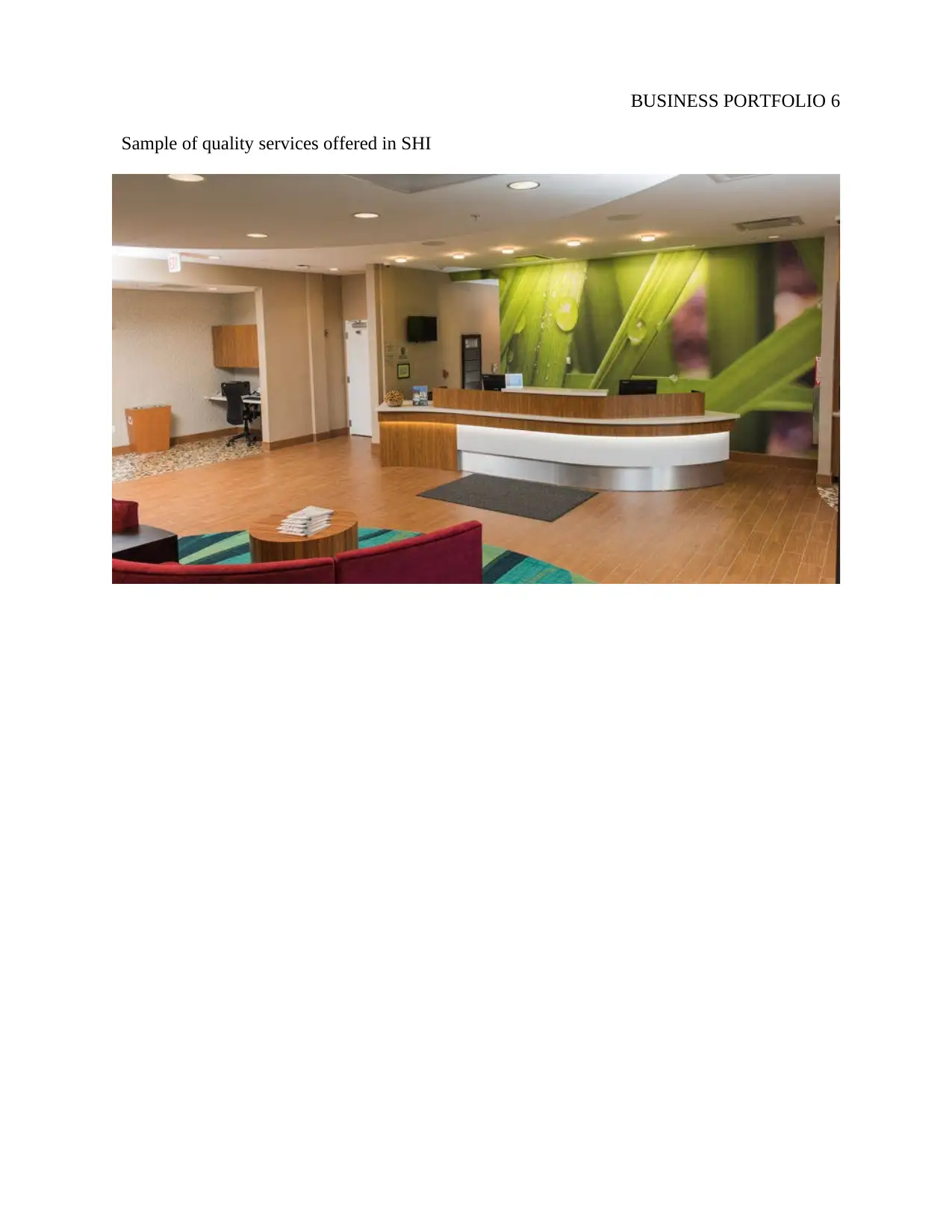
BUSINESS PORTFOLIO 6
Sample of quality services offered in SHI
Sample of quality services offered in SHI
⊘ This is a preview!⊘
Do you want full access?
Subscribe today to unlock all pages.

Trusted by 1+ million students worldwide
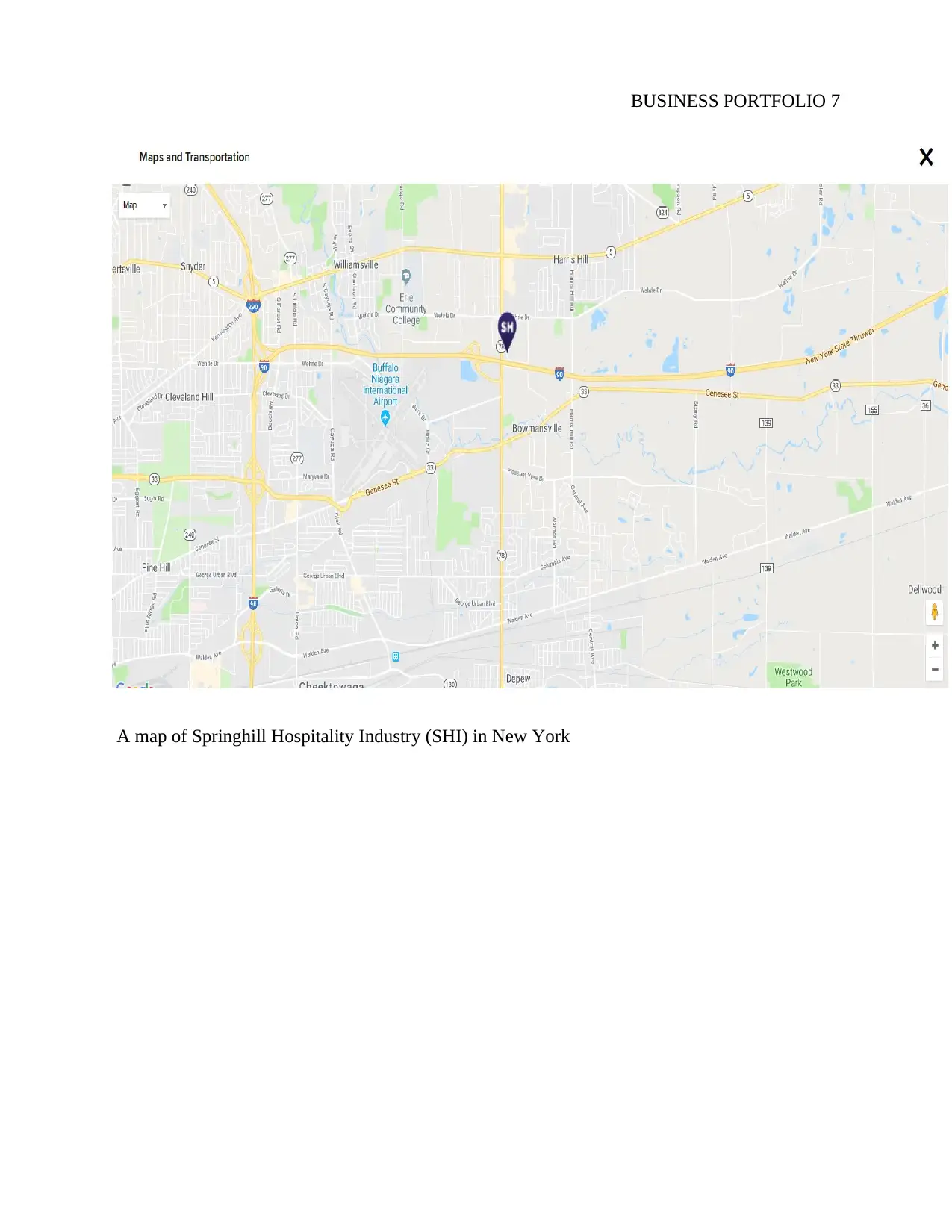
BUSINESS PORTFOLIO 7
A map of Springhill Hospitality Industry (SHI) in New York
A map of Springhill Hospitality Industry (SHI) in New York
Paraphrase This Document
Need a fresh take? Get an instant paraphrase of this document with our AI Paraphraser
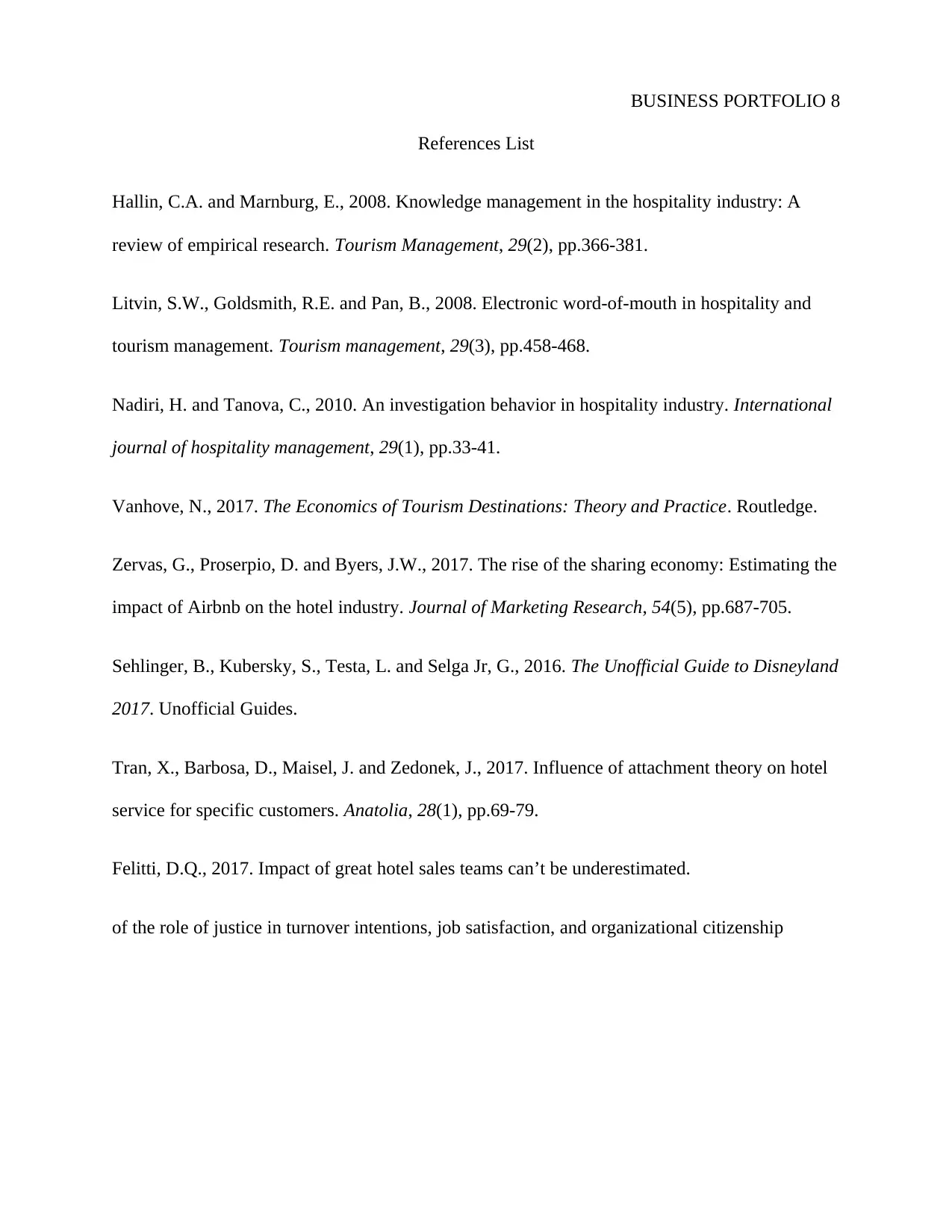
BUSINESS PORTFOLIO 8
References List
Hallin, C.A. and Marnburg, E., 2008. Knowledge management in the hospitality industry: A
review of empirical research. Tourism Management, 29(2), pp.366-381.
Litvin, S.W., Goldsmith, R.E. and Pan, B., 2008. Electronic word-of-mouth in hospitality and
tourism management. Tourism management, 29(3), pp.458-468.
Nadiri, H. and Tanova, C., 2010. An investigation behavior in hospitality industry. International
journal of hospitality management, 29(1), pp.33-41.
Vanhove, N., 2017. The Economics of Tourism Destinations: Theory and Practice. Routledge.
Zervas, G., Proserpio, D. and Byers, J.W., 2017. The rise of the sharing economy: Estimating the
impact of Airbnb on the hotel industry. Journal of Marketing Research, 54(5), pp.687-705.
Sehlinger, B., Kubersky, S., Testa, L. and Selga Jr, G., 2016. The Unofficial Guide to Disneyland
2017. Unofficial Guides.
Tran, X., Barbosa, D., Maisel, J. and Zedonek, J., 2017. Influence of attachment theory on hotel
service for specific customers. Anatolia, 28(1), pp.69-79.
Felitti, D.Q., 2017. Impact of great hotel sales teams can’t be underestimated.
of the role of justice in turnover intentions, job satisfaction, and organizational citizenship
References List
Hallin, C.A. and Marnburg, E., 2008. Knowledge management in the hospitality industry: A
review of empirical research. Tourism Management, 29(2), pp.366-381.
Litvin, S.W., Goldsmith, R.E. and Pan, B., 2008. Electronic word-of-mouth in hospitality and
tourism management. Tourism management, 29(3), pp.458-468.
Nadiri, H. and Tanova, C., 2010. An investigation behavior in hospitality industry. International
journal of hospitality management, 29(1), pp.33-41.
Vanhove, N., 2017. The Economics of Tourism Destinations: Theory and Practice. Routledge.
Zervas, G., Proserpio, D. and Byers, J.W., 2017. The rise of the sharing economy: Estimating the
impact of Airbnb on the hotel industry. Journal of Marketing Research, 54(5), pp.687-705.
Sehlinger, B., Kubersky, S., Testa, L. and Selga Jr, G., 2016. The Unofficial Guide to Disneyland
2017. Unofficial Guides.
Tran, X., Barbosa, D., Maisel, J. and Zedonek, J., 2017. Influence of attachment theory on hotel
service for specific customers. Anatolia, 28(1), pp.69-79.
Felitti, D.Q., 2017. Impact of great hotel sales teams can’t be underestimated.
of the role of justice in turnover intentions, job satisfaction, and organizational citizenship
1 out of 8
Related Documents
Your All-in-One AI-Powered Toolkit for Academic Success.
+13062052269
info@desklib.com
Available 24*7 on WhatsApp / Email
![[object Object]](/_next/static/media/star-bottom.7253800d.svg)
Unlock your academic potential
Copyright © 2020–2025 A2Z Services. All Rights Reserved. Developed and managed by ZUCOL.





